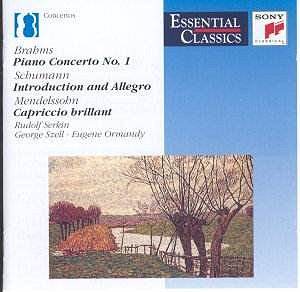 Composer: Karel Ančerl
Composer: Karel Ančerl
Works: Shostakovich: Festive Overture; Novák: In the Tatra Mountains; Krejzí: Serenade for Orchestra; Janáček: Taras Bulba; Mácha: Variations on a Theme by and on the Death of Jan Rychlík; Smetana: Vltava; Dvořák: Symphony No. 8; Slavonic Dance Op. 46 No. 8; Martinů: Symphony No. 5
Performers: Czech Philharmonic Orchestra, Vienna Symphony Orchestra, Concertgebouw Orchestra, Toronto Symphony Orchestra
Recording: Live recordings from 1950-1971, various venues
Label: EMI
Karel Ančerl stands as a pivotal figure in the 20th-century conducting landscape, particularly for his dedication to Czech repertoire and his adept interpretations of both well-known and obscure composers. This collection showcases not only Ančerl’s artistic vision but also the rich tapestry of Czech orchestral music from the early to mid-20th century, a time marked by cultural upheaval and artistic innovation. The works selected for this two-disc set span a range of styles and emotional landscapes, from the vibrant nationalism of Dvořák to the modernist sensibilities of Martinů, offering listeners a comprehensive view of Ančerl’s interpretative prowess.
The recording quality, particularly in the earlier works, is commendable given the era of their capture, revealing Ančerl’s talent for balancing the orchestra’s lush sounds with the clarity of individual instrumental lines. His interpretation of Shostakovich’s Festive Overture is particularly striking; the buoyant rhythms and bright orchestration are rendered with an infectious energy that sets an exhilarating tone for the collection. The brass section’s crisp articulation and the strings’ buoyant phrasing reflect Ančerl’s precise control over the ensemble, ensuring that the overture’s exuberance is fully realized without veering into superficiality.
Ančerl’s approach to Vítězslav Novák’s In the Tatra Mountains exemplifies his ability to navigate the subtleties of color and texture. The work, often overshadowed by the more famous compositions of his contemporaries, receives a nuanced reading that highlights its lyrical beauty and evocative soundscapes. The recording, though mono, captures the warmth of the strings and the ethereal quality of the woodwinds, particularly in the serene passages that evoke the Czech landscape. Ančerl’s choice to emphasize the interplay between the sections reveals a deep understanding of the work’s structural underpinnings.
The Krejzí Serenade for Orchestra further showcases Ančerl’s skill in bringing lesser-known works to life. Its playful character is enhanced by the energetic outer movements and a tender, introspective middle movement that contrasts effectively with the surrounding exuberance. Ančerl’s interpretation aligns with the playful spirit of the piece, emphasizing the lively dialogue between instruments. The technical prowess of the orchestra is on full display, with clear delineation of melodic lines and a cohesive ensemble sound that speaks to Ančerl’s meticulous rehearsal practices.
The engineering quality of these recordings, particularly the later ones, is noteworthy. The live performance of Dvořák’s Symphony No. 8 with the Concertgebouw Orchestra captures the vibrant interplay among the woodwinds, brass, and strings, with the recording allowing for a full appreciation of the symphony’s orchestral color. Ančerl’s reading is lively and autumnal, reminiscent of Brahms’ Third Symphony, bringing a delightful warmth and depth to the work. The flutes and clarinets, particularly in the allegretto grazioso, soar with lyrical beauty, while the finale’s Furiant is executed with a thrilling sense of urgency and rhythmic vitality.
Ančerl’s interpretation of Martinů’s Symphony No. 5 is marked by a vigorous and rhythmically alive performance, reflecting the composer’s neo-classical influences while asserting a distinctly romantic sensibility. The Toronto Symphony Orchestra’s technical precision and Ančerl’s dynamic conducting combine to produce a performance that is both joyous and sophisticated. The CBC recording captures the crystalline textures of Martinů’s orchestration, with every detail emerging distinctly — an achievement that is particularly impressive given the challenges posed by the work’s complexity.
The final work on the second disc is Smetana’s Vltava, where Ančerl takes a more poetic and contemplative approach compared to more frenetic interpretations. The detailed attention to the flowing lines and the delicate interplay of thematic material results in a moving rendition that evokes the river’s serene journey through the Czech landscape. Ančerl’s ability to create a sense of space and fluidity is enhanced by the excellent engineering, which allows the listener to experience the work’s intricate orchestral textures fully.
This collection not only serves as a tribute to Ančerl’s legacy but also highlights the rich diversity of Czech orchestral music. The careful curation of these recordings, along with Patrick Lambert’s informative notes, provides an engaging context for listeners to appreciate the historical and cultural significance of the repertoire. Ančerl’s deep affinity for the music, combined with his outstanding interpretative choices, renders this collection a significant addition to the discography of one of the 20th century’s great conductors. Each performance stands as a testament to Ančerl’s artistry, ensuring that both aficionados and new listeners will find much to explore and enjoy within this remarkable set.



